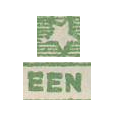Stellaland Philately - Identifying forged stamps
Introduction
The Republic of Stellaland, founded in January 1883, issued its first and only set of stamps in February 1884.
Less than two years later, in September 1885, a British expeditionary force under
Sir Charles Warren abolished the Republic and formally annexed it to British Bechuanaland.
The stamps of Stellaland remained on sale for a few more months before being superseded by the stamps of British Bechuanaland in December 1885.
Surprisingly, despite this short-lived republic being of little consequence, its legacy lives on in a set of five rather unremarkable stamps which seem to have found favour with forgers world-wide.

Presumably, then, it is the simple single colour design, along with the relative scarcity of the genuine stamps that have caused these to be a popular target for forgery.
Identification
When genuine stamps are available to compare with, many forgeries are relatively easy to distinguish, as the colour and paper differences are often quite noticeable.
Another telltale sign of a forgery is that many are not perforated the 11 ½ to 12 found on the genuine stamps.
If still in doubt, there are eight distinguishing features that may be used to identify a genuine stamp:

- Two lines of shading in the upper right quadrant of the shield protrude into the left of the star, the top line more so than the lower.
- The 3rd and 4th lines of shading in the upper right quadrant of the shield are further apart than the others
- A ball at the top of the S of STELLALAND
- There is a minute dot level with the top and just before the second E of REPUBLIEK
- There is a ball at the base of the upright of the R of REPUBLIEK
- The upper point of the left leaf below the shield does not touch the scroll
- The bottom point of the left leaf below the shield has its tip cut through
- There is a minute dot after the S and a second one above the T of POSTZEGEL
 Furthermore, the genuine 1 shilling stamp has another two distinguishing features. Namely a white spot to the left of the central point of the star
in the shield, as well as the first letter 'E' of the word EEN being slightly raised with respect to the other letters.
Furthermore, the genuine 1 shilling stamp has another two distinguishing features. Namely a white spot to the left of the central point of the star
in the shield, as well as the first letter 'E' of the word EEN being slightly raised with respect to the other letters.
The distinguishing features listed above are of little help when attempting to identify forged stamps produced from one of the original lithograph stones that
had somehow been obtained from the printing company.
As the value tablet was not part of the stone, the forgers used the length of the ZES PENCE to determine the size of the value tablets.
As a result, except for the sixpence, the value tablets of the other four denominations are shorter than those found on the genuine stamps and can
be used to identify these otherwise difficult forgeries.
| Value | Genuine | Forgery |
|---|---|---|
| EEN PENNY | 13.5mm | 12.5mm |
| DRIE PENCE | 14.5mm | 13.5mm |
| VIER PENCE | 15mm | 13.5mm |
| ZES PENCE | 17mm | 17mm |
| EEN SHILLING | 17mm | 15mm |
Cancellations
Stellaland did not possess a cancelling device, instead, stamps were cancelled by hand using pen and ink. The most common cancellation being in the form of the
postmaster's initials along with the date. Genuine cancellations are also found with only the date or the stroke of a pen.
Post from Stellaland may also be found with the postmarks of transit or receiving post offices which included Christiana in the Transvaal, and Kimberley or Barkly West in the Cape.
References
- H. R. Holmes - The Postage Stamps, Postal Stationery, and Postmarks of the Bechuanalands
Royal Philatelic Society, London, 1971 - Stanley Gibbons Commonwealth Stamp Catalogue Southern and Central Africa, 1st Edition 2011
Stanley Gibbons Ltd, 2011 - The South African Stamp Colour Catalogue, 30th Edition 2010/11
Tracinda Publications (Pty) Ltd, 2010
